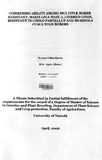Combining ability among multiple borer resistant,maize (zea mais, L.) inbred lines, resistant to chilo partellus and busseola fusca stem borers
Abstract
Maize (Zea mays L.) is an important cereal crop of the world. It has worldwide significance as human
food, animal feed and raw material for the manufacture of many industrial products. The most
important insect pests of maize in Kenya are Chilo partellus and Busseola fusca stem borers. These two
stem borers causes loss in maize worth Kshs. 7.2 billion. The objective of this work was to determine
the combining ability of twenty insect resistant inbred lines. A partial Diallel mating design was used.
One hundred and ten single crosses were made to give one hundred and ten FI hybrids. The FI hybrids
were evaluated for insect resistance in two different sites i.e. in Lowland and Mid altitude areas for two
seasons. The FI hybrids and two local checks (pH3253 and H513) were artificially infested with black
head eggs of Chilo partellus and Busseola fusca stem borers for Kiboko and Embu respectively. The
Fl hybrids and two local checks were planted in a five meter row plot which was later divided into two.
Half of the plot was infested with respective stem borer while the other half was protected against stem
borer using a systemic insecticide. Thirteen traits were recorded to determine the combining ability of
the inbred lines. The traits that were recorded to determine resistance included: stem borer damage, exit
holes, tunnel length plant height ratio, tunnel length and yield loss. In both Kiboko and Embu inbred
lines; 5, 6, 8, 10, II, 14, and 16 showed negative general combining ability (GCA) effects for the insect
damage. The GCA: Specific combining ability (SeA) ratio was higher in both Embu and Kiboko, an
indication of higher GCA variances; the range was from 0.35 to 0.90 at Embu and 0.46 to 1.32 at
Kiboko. Inbred lines 18, 19 and 20 were found to be good combiners for yield in both Embu and
Kiboko. The Fl hybrids which were made with inbred line 3 as the male performed well in terms of
insect resistance and yield and this proved it was a desirable good combiner. These good crosses
included; 3x18, 3x9, 3x13, 3x1O and 3x14. Single crosses 3x18 and 3x14 were the best combiners for
yield with 6.71 and 5.15 tons per hectare respectively. These crosses can be used to form synthetics
when allowed to pollinate them selves or be used as single cross hybrids in the formation of three way
or double cross hybrids. However, a number ofFl hybrids performed worse than the two susceptible
checks and this calls for more evaluation and screening for insect resistance to improve these varieties.
The yield loss margin for the F 1 hybrids was minimal compared to the two local checks. A negative
low but significant correlation between plant height and stem borer damage was observed (r= -0.02).
The results reported in this study show that selection for resistance varieties to the two stem borers,
namely C. partellus and B. fusca would result in significant correlated responses in increased grain
yield in maize.
Citation
Karaya, G. H.(2006).Combining ability among multiple borer resistant,maize (zea mais, L.) inbred lines, resistant to chilo partellus and busseola fusca stem borersSponsorhip
University of NairobiPublisher
Department of Plant Science and Crop Protection, University of Nairobi
Description
Msc- Thesis

